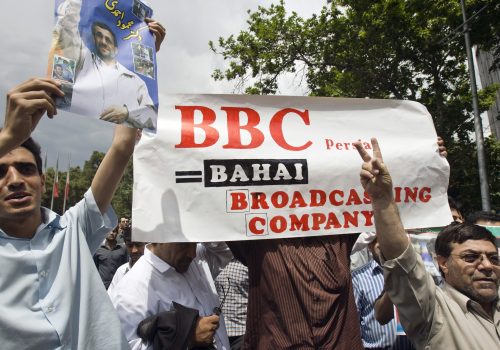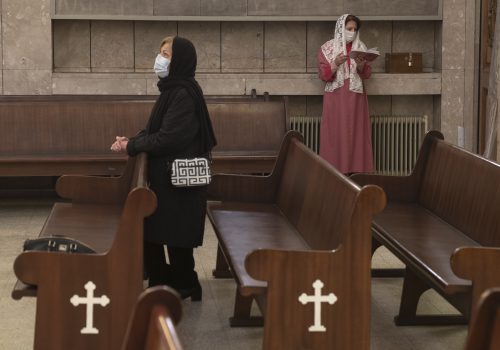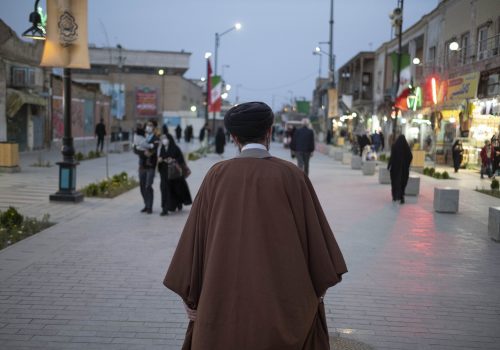The Islamic Republic is on the path to committing a mass atrocity. The world should pay attention.
NOTE: Updated on
According to the Human Rights Activists News Agency (HRANA), since Mahsa Jina Amini was killed by the so-called morality police in September 2022, demonstrations have occurred in at least 163 cities and at 144 universities in Iran. Security forces have killed over five hundred protesters and over nineteen thousand have been detained. Sunni majority-ethnic minorities in Kurdistan province and Sistan and Baluchistan province have experienced persecution at a greatly elevated scale. Amidst such extensive repression, it would be easy to forget the plight of smaller minority groups such as the Baha’is, whose experience has long been a microcosm of what the country as a whole is currently suffering.
A month and a half before the killing of Amini, on July 31, Fariba Kamalabadi and Mahvash Sabet, the two female members of the long-disbanded informal leadership group of the Baha’is of Iran—known as Yaraneh Iran (“Friends of Iran”)—were arrested. Kamalabadi and Sabet are serving ten-year prison sentences handed down on November 21, 2022—a cruel repetition of their 2008-2018 incarceration and part of the widespread crackdown on Baha’is that began in June 2022.
The persistent and systematic nature of the Baha’i experience strongly suggests that it would be worthwhile to freshly examine the community’s vulnerability in the current context to determine whether this already beleaguered community is at increased risk of larger-scale abuses. The discussion that follows will examine the risks posed to the Baha’i community through the lens of two existing frameworks for analyzing the potential for atrocity crimes: the United Nations Framework of Analysis for Atrocity Crimes and the Early Warning Project of the United States Holocaust Memorial Museum.
In an article published on October 3, 2022, the state-controlled Ferghe News falsely asserted that Baha’is have been responsible for “rioting, burning, destruction, and murder,” during the ongoing protests. Hate propaganda directed against the Baha’is is pervasive and typical allegations against the community include espionage, opposing Islam, and immorality. According to the Baha’i International Community, during the six months ending with April 2021, state-sponsored traditional and social media were broadcasting or posting over 950 anti-Baha’i pieces per month on average. This had risen over the years from approximately twenty-two per month during the seventeen months from mid-December 2009 to mid-May 2011.
Given that atrocities such as genocide, crimes against humanity, ethnic cleansing, and war crimes are invariably associated with hate propaganda, this indicator for the Risk Factor, Enabling Circumstances and Preparatory Action, (Risk Factor 7, Indicator 14, in the UN Framework, hereinafter “RF 7.14”)—together with other indicators of atrocity risk factors—deserves serious attention. In a welcome development, in July 2022, the US government announced its renewed strategy—implemented by a White House-led Atrocity Prevention Task Force—to anticipate, prevent, and respond to atrocities. In its strategy, the United States indicated that it utilizes quantitative and qualitative assessments to identify priority countries for atrocity prevention efforts.*
Assessing a new mass atrocity under the Early Warning Project
The Early Warning Project assesses the likelihood of a new mass atrocity—the killing of at least one thousand people within a twelve-month period—taking place in a particular country over the course of the ensuing two years by utilizing common variables and conditions that have existed in many countries just before mass atrocities have taken place. Some of these variables, such as the size of a country’s population, appear to have no causal link to the occurrence of atrocities. Yet, they correlate strongly with them, so they are employed in the model. Others, such as whether civil society is repressed, would strike anyone as having a high correlation with atrocities.
When last assessed at the end of 2021 by the Early Warning Project, the Islamic Republic ranked thirtieth among 162 countries with respect to the likelihood of a mass atrocity occurring during the period spanning 2022-2023. Since 1994, two-thirds of all mass atrocities have occurred in countries ranked among the top thirty. Of the twenty-five variables utilized for Iran, one appears to have changed significantly during 2022. The severe crackdown on the protests since September 2022 appears to warrant a changed determination for the variable “repression of civil society.” The model uses a simple “Yes” and “No” distinction. Given the severity and the breadth of the crackdown, the “No” assessed in 2021 appears likely to change to “Yes.” Additionally, with none of the other variables appearing to have improved, one would readily surmise that, under this forecasting tool, Iran’s 2.4 percent likelihood of having a mass atrocity during the 2022-2023 period will have risen significantly for 2023-2024.
This strongly suggests that, for minorities such as the Baha’is, as well as Gonabadi Sufis, Christian converts, and largely Sunni ethnic minorities (e.g., Kurds and Baluchis), a heightened level of vigilance is appropriate to detect the onset of events that could trigger an attempted mass atrocity. Moreover, once a country has completed a mass atrocity, one of the variables of the Early Warning Project indicates that its completion increases the likelihood that an atrocity against another group will occur soon. Hence, in the case of the Islamic Republic, the completion of an atrocity, such as the killing in a twelve-month span of a total of one thousand protesters in 2022-2023, would increase the likelihood that an atrocity against another group will occur shortly thereafter. That over five hundred killings of protesters have already occurred through January 2023 tragically places the one thousand threshold well within reach.
Worldwide, new mass atrocities—as opposed to ongoing multi-year ones—occur infrequently, on average two to three per two-year period, according to the Early Warning Project. Thus, the likelihood of one occurring against the Baha’is in the next two years, though significantly elevated due to the severely increased repression of civil society, is not extraordinarily high. On the other hand, a surge in persecution victimizing over four hundred Baha’is occurred during the last two–thirds of 2022. It included raids, arrests, detentions, beatings, sentencings, property demolitions and confiscations, and exclusions from university education.
Using the UN Framework
Unlike the Early Warning Project, the UN Framework’s fourteen risk factors are not weighted. Based on the country context, a user of the UN Framework must determine how heavily to weigh each risk factor and the several indicators employed in assessing said risk factor.
The alarming rise in hate propaganda (RF 7.14) has been described above. Government orders to track the Baha’is and monitor their activities (RF 5.2) at the provincial and local levels have made possible the rapid detention of virtually all Baha’is.
With respect to historical oppression, (RFs 9.1, 9.2, and 9.3), the community has experienced persecution since its inception. For example, in the mid-nineteenth century, between ten thousand and twenty thousand Baha’is were killed. Furthermore, over 210 Baha’is were killed from 1979 through 1998, mainly after summary trials and executions of those in elected leadership positions.
Marginalization of the Baha’is (RFs 10.1, 10.3, and 10.8) occurred through their dismissal from government employment after the 1979 revolution; their banning from twenty-five professions; the arbitrary closure of small businesses; and the exclusion of Baha’i youth from the country’s system of higher education since the early 1980s. This marginalization is explicitly endorsed in a 1991 Memorandum of the Supreme Revolutionary Cultural Council, which was signed by Supreme Leader Ayatollah Ali Khamenei and reinforced by his repeated fatwas against the “perverse sect.” The 1991 Memorandum has been cited by national, provincial, and local authorities to justify measures against the Baha’is.
The lack of an independent and impartial judiciary (RF 3.3) has been evidenced by decisions rendered in late 2020 that legitimized the seizure of property owned by Baha’is based simply on their religion and by the aforementioned incarceration and sentencing of Kamalabadi and Sabet. As of December 2022, there were at least ninety Baha’is in prison or with tracking ankle bands, the largest number since December 2017. Over one thousand are in some stage of the criminal justice system, from initial arrest to final appeal and sentencing. The enactment in 2021 of amendments to Articles 499 and 500 of Book V of the Islamic penal code effectively outlawed any action in support of any religious minority—including the Baha’is—that is not recognized under the Islamic Republic’s constitution.
The instability caused by the regime’s crackdown on persistent mass protests since mid-September 2022 (RF 1.10) constitutes the most worrisome recent development affecting the possibility of genocide or some other form of atrocity.
None of this augurs well for the Baha’i community. The situation warrants that both the United Nations—through its various mechanisms—and the US government—through its White House-led Task Force and its State Department—closely monitor the status of the Baha’is and other religious and ethnic minorities. In such a volatile social and political environment, unexpected events can trigger scapegoating and the resurrection of debunked allegations to support genocide or other atrocities. Speaking out early with warnings is essential. History has shown that it is better to appear premature in speaking out and not be proven right than to speak out late and be irreparably wrong.
*Clarification: An earlier version of this article stated that the United States utilizes the atrocity forecasting tools of the UN Framework and the Early Warning Project, but the State Department’s strategy does not specify which forecasting tools it uses.
Anthony N. Vance is director of public affairs for the Baha’is of the United States. He served primarily as a lawyer for twenty-one years in USAID, mainly on the African continent.
Further reading
Mon, Apr 26, 2021
Iran must end its relentless violations against the Baha’is
IranSource By
Iran's human rights violations against Baha’is have been distinctly state-driven, multifaceted, and severe.
Tue, Sep 21, 2021
Iranian children are being punished based on their parents’ religion and beliefs
IranSource By
In practice, Iran’s discriminatory law affects almost all aspects of minority children’s lives, such as safety and well-being and access to health and education.
Wed, Dec 14, 2022
Iran’s protests intensify calls for Shia clerics to step back from politics
IranSource By
Even before the outbreak of nationwide protests following the beating death of Mahsa Jina Amini, voices within the seminaries have been calling for a reduction of the role of the clergy in political affairs.
Image: Protesters perform an execution scene with ropes around their necks during the demonstration. Mahsa Amini's death has sparked weeks of violent protests across Iran and other countries. Mahsa fell into a coma and died after being arrested in Tehran by the morality police for allegedly violating the country's hijab rules. (Photo by Onur Dogman / SOPA Images/Sipa USA)


